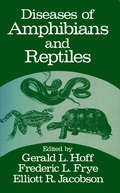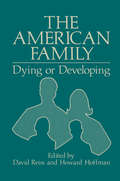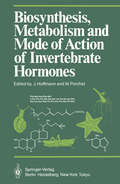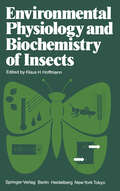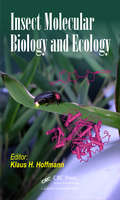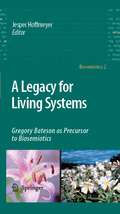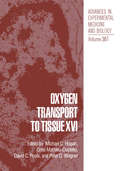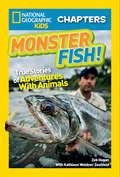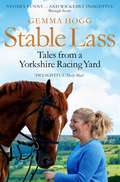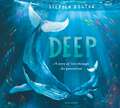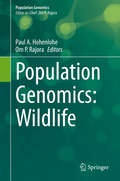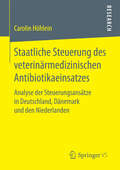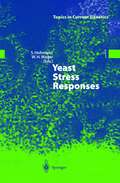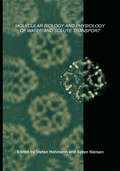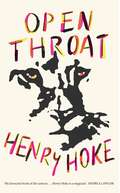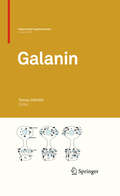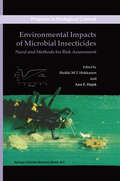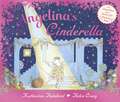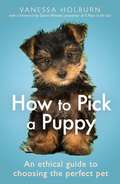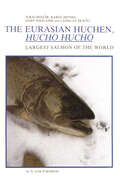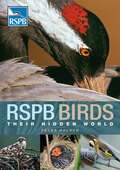- Table View
- List View
Diseases of Amphibians and Reptiles
by Gerald HoffWhile diseases of free-ranging and captive mammalian and avian wildlife species have received considerable interest in the past 25 years, those of amphibians and reptiles (collectively, the herptiles) generally have been assigned lesser importance. The literature concern ing disease in herptiles is widely scattered, consisting chiefly of case reports and prevalence surveys, and with heavy emphasis on captive reptiles. The dynamics of the host-agent-environment relationship have been studied for only a few diseases. This diverse data base is primarily a function of the paucity of investigators whose chief interest is in diseases of herptiles. This first edition represents an effort to bring together some of the diffuse knowledge on infectious and non-infectious diseases of free-ranging and captive herp tiles. Issue may be taken with the choice of topics; how ever, predominant diseases, as well as some diseases of lesser prominence, are presented. The editors were forced to accept certain omissions, particularly with amphibian diseases, simply for lack of contributors. The resulting text, however, we hope will be of value to veterinarians, herpetolo,gists, wildlife disease investigators, wildlife managers, zoo curators, and university students. G.L. Hoff F.L. Frye E.R. Jacobson v CONTENTS Mycobacteriosis 1 D.G. Brownstein Pasteurella in Reptiles 25 K.P. Snipes Pseudomonas 37 E.R. Jacobson Areomonas 49 E.B. Shotts, Jr.
The American Family: Dying or Developing
by Howard HoffmanSeveral years ago, an anonymous donor gave a generous gift to the Department of Psychiatry and Behavioral Sciences at George Washington University School of Medicine. The donor suggested that the gift be used to support a conference on the current dilem mas of the American family and to publish its proceedings. The current chairman of the department, Jerry Wiener, formulated the initial plans for the conference with Leon Yochelson, who had been chairman at the time the gift was made. Dr. Yochelson is now Chairman of the Board of the Psychiatric Institute of the District of Columbia. These initial discussions led to a significant and sus tained collaboration between the Department of Psychiatry and Behavioral Sciences at George Washington and the Psychiatric In stitute in planning the conference and the present volume. A committee was established to plan the conference. It con sisted of Peter Steinglass, Associate Professor of Psychiatry, and George Cohn, Professor of Child Health and Development, both of George Washington, and Margaret Garrett, a member of the psychiatric staff at the Psychiatric Institute. The committee was jointly chaired by the editors of this volume. The committee re ceived indispensable assistance from members of the administra tive staff of the Psychiatric Institute: Al Bruce, Carol Klein, and Miriam Mathura. Margaret Schnellinger of the Center for Family Research, George Washington University, was also very helpful in all phases of planning the conference.
Biosynthesis, Metabolism and Mode of Action of Invertebrate Hormones (Proceedings in Life Sciences)
by J. Hoffmann M. PorchetEnvironmental Physiology and Biochemistry of Insects
by K. H HoffmannOf all the zoological classes the insects are the most numerous in species and the most varied in structure. Estimates of the number 18 of species vary from 1 to 10 million, and 10 individuals are es timated to be alive at any given moment. In their evolution, in sects are relatively ancient and, therefore, they have proved to be a phenomenally successful biological design which has survived unchanged in its basic winged form during the last 300 m. y. In sects were the first small animals to colonize the land with full suc cess. Their small size opened many more ecological niches to them and permitted a greater diversification than the vertebrates. What is it about this design that has made insects so successful in habitats stretching from arid deserts to the Arctic and Antarctic and from freshwater brooks to hot springs and salines? Is it due to the adapta bility of their behavior, physiology, and biochemistry to changing environmental conditions? Three features of insects are of particular importance in determin ing their physiological relationship with the environment: their small size, as mentioned above, the impermeability and rigidity of their exoskeleton, and their poikilothermy. Of course, as with any other animals, the insects' success in its environment depends on its ability to maintain its internal state within certain tolerable limits of temperature, osmotic pressure, pH or oxygen concentra tion (homoeostasis).
Insect Molecular Biology and Ecology
by Klaus H. HoffmannInsects represent the most abundant and diverse animal group on Earth. The number of described species is more than one million and up to ten million are estimated. Insects have one of the widest distributions in the world because they have adapted to extreme ranges of environments.Molecular ecology studies ecological processes based on the analysi
A Legacy for Living Systems: Gregory Bateson as Precursor to Biosemiotics (Biosemiotics #2)
by Jesper HoffmeyerGregory Bateson’s contribution to 20th century thinking has appealed to scholars from a wide range of fields dealing in one way or another with aspects of communication and epistemology. A number of his insights were taken up and developed further in anthropology, psychology, evolutionary biology and communication theory. But the large, trans-disciplinary synthesis that, in his own mind, was his major contribution to science received little attention from the mainstream scientific communities. This book represents a major attempt to revise this deficiency. Scholars from ecology, biochemistry, evolutionary biology, cognitive science, anthropology and philosophy discuss how Bateson's thinking might lead to a fruitful reframing of central problems in modern science. Most important perhaps, Bateson's bioanthropology is shown to play a key role in developing the set of ideas explored in the new field of biosemiotics. The idea that organismic life is indeed basically semiotic or communicative lies at the heart of the biosemiotic approach to the study of life. The only book of its kind, this volume provides a key resource for the quickly-growing substratum of scholars in the biosciences, philosophy and medicine who are seeking an elegant new approach to exploring highly complex systems.
Oxygen Transport to Tissue XVI (Advances in Experimental Medicine and Biology #361)
by Michael C. Hogan Odile Mathieu-Costello David C. Poole Peter D. WagnerSince its inception in 1973, The International Society on Oxygen Transport to Tissue (ISOTT) has provided a unique forum to facilitate and encourage scientific interaction and debate. Welcoming scientists and clinicians from a broad spectrum of disciplines, each with their own particular skills and expertise, ISOTT unites them under the common theme of oxygen transport. The successful blend of scientific presentations and informal discussion which characterizes ISOTT is epitomized best by the many fundamental discoveries and technical advancements which it has spawned. The breadth and strengths of The Society's scientific base promotes the rapid progression of ideas from theoretical concepts to rigorous scientific testing and often, ultimately to the clinical arena. Each publication of the ISOTT proceedings has been recognized by Science Citation Index listing and the papers frequently establish scientific precedents and become considered as standard works in their respective fields. The 21st ISOTT Meeting was held in San Diego from August 14th through August 18th, 1993. The San Diego Meeting attracted about 150 registrants and 40 accompanying persons. Ten state-of-the-art lectures were presented by international experts in ~ transport and there were in addition two symposia -one dealing with assessment of tissue hypoxia and the other with functional heterogeneity in different organ systems. There were 100 free communications, consisting of posters accompanied by an abbreviated oral summary. All manuscripts were reviewed by the Editors for form and content, but as is customary for the ISOTT proceedings, rigorous scientific peer review was not undertaken.
National Geographic Kids Chapters: True Stories Of Adventures With Animals (National Geographic Kids Chapters)
by Zeb Hogan Kathleen Weidner Zoehfeld National Geographic KidsFor Zeb Hogan, bigger is better – especially when it comes to fish. From sawfish to alligator gars to giant stingrays, Zeb's on a mission to save the world's freshwater giants. In this cool Chapter book, you'll join Zeb on amazing – and TRUE – adventures with supersize swimmers. From the Trade Paperback edition.
Stable Lass: Riding Out and Mucking In - Tales from a Yorkshire Racing Yard
by Gemma Hogg'Poignant and compelling, an equine Bridget Jones.' Racing PostBeing a stable lass is probably one of the hardest jobs in the country, and yet for Gemma Hogg it is the most rewarding. She works in the beautiful Yorkshire market town of Middleham and if her colleagues are occasionally challenging, then the horses are downright astonishing. Now, in Stable Lass, she takes us into the closed world of a top racing yard, from the elation of having several winners in one day to the almost indescribable grief of losing a horse. Like most stable lads and lasses, Gemma arrived in her yard as a teenager fresh out of racing college and had to cope with living away from home for the first time, as well as adapting to the brutal long hours, backbreaking work and often treacherous weather. She describes falling in love with Polo Venture, the first racehorse in her care, the pure exhilaration of riding him on Middleham Gallops for the first time and what happens when a horse takes against you, from the growling gelding Valiant Warrior to the potentially lethal Broadway Boy. She brings to life the characters around the yard, from straight-talking boss Micky Hammond to the jockeys starving themselves to make weight, the wealthy owners and the other stable lads and lasses who come from a range of different places and backgrounds. Stable Lass by Gemma Hogg is a unique look into the world of horse racing filled with heart-warming stories and amazing thoroughbreds – some loveable, some cantankerous, all impressive.
DEEP
by Stephen Hogtun“Go my little one, swim free,” she whispered. “I'll always be waiting here . . .” When a tiny whale calf is born, his mother raises him to the surface to take his first breath. She guides him as he grows, until he is strong enough to swim at her side, and they set off together on a great journey across the oceans. One day, the time will come for the grown calf to set out on his own . . . but wherever he goes and whatever he does, his mother will be waiting for him and sending her song of love across the oceans. Filled with beautiful, luminous artwork, this stunning picture book tells a universal story about love and family that's perfect for readers young and old.
Population Genomics: Wildlife (Population Genomics)
by Paul A. Hohenlohe Om P. RajoraPopulation genomics is revolutionizing wildlife biology, conservation, and management by providing key and novel insights into genetic, population and landscape-level processes in wildlife, with unprecedented power and accuracy. This pioneering book presents the advances and potential of population genomics in wildlife, outlining key population genomics concepts and questions in wildlife biology, population genomics approaches that are specifically applicable to wildlife, and application of population genomics in wildlife population and evolutionary biology, ecology, adaptation and conservation and management. It is important for students, researchers, and wildlife professionals to understand the growing set of population genomics tools that can address issues from delineation of wildlife populations to assessing their capacity to adapt to environmental change. This book brings together leading experts in wildlife population genomics to discuss the key areas of the field, as well as challenges, opportunities and future prospects of wildlife population genomics.
Staatliche Steuerung des veterinärmedizinischen Antibiotikaeinsatzes: Analyse der Steuerungsansätze in Deutschland, Dänemark und den Niederlanden
by Carolin HöhleinCarolin Höhlein untersucht vor dem Hintergrund steigender Antibiotikaresistenzen und der damit verbundenen Notwendigkeit der Reduktion der Einsatzmengen nationale veterinärmedizinische Minimierungskonzepte und prüft deren potentielle Treffsicherheit sowie auftretende Nebenwirkungen. Schwerpunkt ihrer Analyse gilt dem in Deutschland verankerten Steuerungsansatz und der 16. Novellierung des Arzneimittelgesetzes (16. AMG Novelle) im Rahmen der Deutschen Antibiotika-Resistenzstrategie (DART). Untersucht werden gleichsam die in Dänemark und den Niederlanden erlassenen Steuerungsansätze. Dabei wird deutlich, dass tiergesundheitliche Aspekte stärker als bisher bei der Entwicklung weiterer Policies mit berücksichtigt werden müssen.
Yeast Stress Responses (Topics in Current Genetics #1)
by Stefan Hohmann Willem H. MagerEvery cell has developed mechanisms to respond to changes in its environment and to adapt its growth and metabolism to unfavorable conditions. The unicellular eukaryote yeast has long proven as a particularly useful model system for the analysis of cellular stress responses, and the completion of the yeast genome sequence has only added to its powerThis volume comprehensively reviews both the basic features of the yeast genral stress response and the specific adapations to different stress types (nutrient depletion, osmotic and heat shock as well as salt and oxidative stress). It includes the latest findings in the field and discusses the implications for the analysis of stress response mechanisms in higher eukaryotes as well.
Molecular Biology and Physiology of Water and Solute Transport
by Stefan Hohmann Søren NielsenBiophysical studies in the 1950ies and 1960ies led to the realization that the water permeability of certain biological membranes must be due to the presence of water transporting proteins. This hypothesis was confirmed in 1991 and 1992 with the pioneering discovery of the first molecular membrane water channel, CHIP28, by Agre and coworkers. This integral membrane protein, which is abundant in the erythrocyte membrane and in many epithelial cells, is now called aquaporin-1 or AQP1. Thus the terms water channel or aquaporin are synonymous. In July 2000 more than 200 researchers came together in Gothenburg, Sweden, for the `3rd International Conference on the Molecular Biology and Physiology of Water and Solute Transport" to discuss progress in this emerging research field. 58 different presentations from this conference are the basis for this book. Cumulatively, these 58 short chapters provide a balanced overview complementing numerous recent reviews in this field.
The Book Your Cat Wishes You Would Read
by Lucy HoileHave you ever wanted to know what your cat was thinking?In The Book Your Cat Wishes You Would Read, feline behaviourist Lucy Hoile gives you all the information you could ever need to build an even better, happier relationship with your cat. Lucy is speaking directly to you, the carer, and is here to support you on this amazing journey.Cats are an enigmatic species and their behaviour is subtle and difficult to read. Because of this, it's not always easy to understand what they need from us and our relationship with them can suffer as a result.Included in this book is information on how cats communicate through body language, vocalisations and their secret language of scent. Deciphering this information helps us understand what they are trying to tell us, including when they are feeling unwell, when they are stressed or when they are feeling perfectly content.Armed with Lucy's invaluable advice you will feel excited and empowered to feel even closer to your cat and build a more loving, patient and rewarding relationship for life.
Open Throat
by Henry HokeA queer and dangerously hungry mountain lion narrates this fever dream of a novel, carrying us on a universal journey through a wondrous and menacing modern day L.A.'A slim jewel of a novel . . . Open Throat is what fiction should be.' - The New York Times Book Review'A blinding spotlight beam of a book that I was completely unable and unwilling to put down.' - Catherine Lacey, author of PewNamed a Most Anticipated Book by The New York Times, ELLE, Vanity Fair, Buzzfeed, i-D, Boston Globe, Nylon, Alta, Shondaland, Chicago Review of Books, Philadelphia Inquirer, and Literary Hub.I’ve never eaten a person but today I might . . .A lonely, lovable, queer mountain lion lives in the drought-devastated land under the Hollywood sign. Fascinated by the voices around them, the lion spends their days protecting a nearby homeless encampment, observing hikers complain about their trauma and, in quiet moments, grappling with the complexities of their own identity.When a man-made fire engulfs the encampment, the lion is forced from the hills down into the city the hikers call 'ellay'. As they confront a carousel of temptations and threats, the lion takes us on a tour that spans the cruel inequalities of Los Angeles. But even when salvation finally seems within reach, they are forced to face down the ultimate question: do they want to eat a person, or become one?Feral and vulnerable, profound and playful, Henry Hoke's debut novel Open Throat is a marvel of storytelling that brings the mythic to life.
Galanin (Experientia Supplementum #102)
by Tomas HökfeltGalanin is a neuropeptide found both in the central and peripheral nervous system. The 29-amino acid peptide (named after its N-terminal glycine and C-terminal alanine) was identified in 1983 by its C-terminal amidation. This 'reverse' approach, that is to discover a substance through a distinct chemical feature, and only subsequently to characterize its biological activity, was novel and has been successful in the identification of several other peptides. After the structure of galanin was determined in 1983, functional studies were performed with material purified from natural sources until the synthetic form of the peptide became available. Galanin can act as transmitter, modulator and trophic factor, and is involved in a number of physiological processes such as hormone secretion, cardiovascular mechanisms, feeding and cognition. This peptide may also be of significance for a number of pathological processes/disorders including pain, depression, Alzheimer's disease, epilepsy, addiction and cancer. This wide diversity of actions is mediated by three galanin receptor subtypes. The studies reviewed in this volume give a fairly complete overview of the spectrum of the biological actions and functions of galanin and its receptors and on possible therapeutic applications in a number of pathological conditions.
Environmental Impacts of Microbial Insecticides: Need and Methods for Risk Assessment (Progress in Biological Control #1)
by Heikki M. T. Hokkanen Ann HajekBiological pesticides are increasingly finding therr place in IPM and increasing numbers of products are making therr way to the marketplace. Particularly in China, Latin America and Australia, implementation is proceeding on a large scale. However, in the USA and Europe, registration procedures for insect pathogens to be used for insect control have been established that requrre low levels of risk, resulting in costs of retarding the implementation of microbial agents. This book provides a review of the state of the art of studies on the envrronmental impact of microbial insecticides. It originates from a Society for Invertebrate Pathology Microbial Control Division Symposium .. Assessment of envrronmental safety of biological insecticides", organised in collaboration with the EU-ERBIC research project (FAIR5-CT97-3489). This symposium was initiated by Heikki Hokkanen and Chris Lomer, and was held at the SIP Annual Meeting in 2001 in The Netherlands. The emphasis in this book is on large scale use of microbial agents for insect control, demonstrating how this use has been proceeding with minimal envrron mental impact. This book is intended to be of use to regulatory authorities in determining whether further studies in eertain areas are necessary and how to conduct them if needed, or whether sufficient information has been collected already to permit fuH registration of many of these biological control agents.
Angelina Ballerina: Angelina's Cinderella (Angelina Ballerina Ser.)
by Katharine Holabird Helen CraigThis eBook has been optimised for viewing on colour devices. Angelina is a pretty little mouse who wants more than anything else to become a ballerina. She dances all the time - even when she's supposed to be doing chores or getting ready for school. Her parents, Mr and Mrs Mouseling, are in despair - but then they think of a plan. They decide it's time for Angelina to go to ballet school - she works hard for years and years until she becomes the famous ballerina Mademoiselle Angelina!
Angelina's Birthday
by Katharine Holabird Helen CraigThis ebook has been optimised for colour devices.It's Angelina's birthday and there's going to be a party. But when Angelina breaks her bicycle while racing her best friend, Alice, she thinks the day will be ruined. Angelina is upset, but her parents encourage her to save up for a new one by doing jobs for people in the village. The day of the party arrives and Angelina gets a wonderful birthday surprise - a brand-new bicycle!
Angelina's Cinderella: Angelina's Cinderella
by Katharine Holabird Helen CraigAngelina is so excited. She's the lead in the Cinderella Dance Tour! Angelina and the company travel all over Mouseland, but as the final performance approaches, all the scenery is accidentally ruined! Will Angelina and her friends save the show?A picture book for all budding ballerinas to treasure with a pop-up finale including a 3D theatre stage, and pull-out characters based on the Cinderella story.
Angelina's Cinderella: Angelina's Cinderella
by Katharine Holabird Helen CraigThis eBook has been optimised for viewing on colour devices.Angelina is so excited. She's the lead in the Cinderella Dance Tour! Angelina and the company travel all over Mouseland, but as the final performance approaches, all the scenery is accidentally ruined! Will Angelina and her friends save the show?A picture book for all budding ballerinas to treasure with a pop-up finale including a 3D theatre stage, and pull-out characters based on the Cinderella story.
How To Pick a Puppy: An Ethical Guide To Choosing the Perfect Pet
by Vanessa HolburnFrom animal welfare campaigner Vanessa Holburn and with a foreword by dog lover and presenter of 'A Place in the Sun' Danni Menzies, this book has everything you need to know to help you pick the perfect pooch for your home and lifestyle.How To Pick a Puppy is the essential handbook to finding a 'furever' dog and ensuring that you have many happy and healthy years together. It contains practical advice on how to research the types and breeds of dog available. It considers the pros and cons of puppies, senior, pedigree and rescue dogs, and explains why one might suit an individual more than another. The book equips the reader with all the right questions they need to ask before they choose a dog and shows them how to find a responsible breeder or rescue centre. It teaches how to avoid the pitfalls of getting the wrong dog from the wrong place, and shows you how to spot and avoid a puppy farmer. It also explains the legal responsibilities of dog ownership and covers the range of hobbies and activities owners and dogs can enjoy together. At each stage of the book, Vanessa's advice is complemented by comment from canine experts such as trainers, behaviourists, breeders and those involved in rescue. Happy dog owners and foster carers also add their experience. In the final section the book guides you through the settling in period, discussing early training, socialisation and vet care, so your first month together can be as smooth as possible.
The Eurasian Huchen, Hucho hucho: Largest Salmon of the World (Perspectives in Vertebrate Science #5)
by J. Holcík K. Hensel J. Nieslanik L. SkácelThe need to gather available data on the Eurasien huchen - an important salmonid species - has been forced by a plain and, unfortunately, common fact of our times: the numbers and distribution of this biggest of salmonids have begun to decline and its range has begun to shrink. A seminar on the huchen - the European form of the species Hucha hucha - held in Zilina in February 1973 as a result of a suggestion of the Section for the Conservation of Fauna of the Slovak Zoological Society, indicated very clearly the sad situation. Data on the biology of the huchen are regrettably scarce despite several recent papers (Ivaska 1951, Svetina 1962, Prawochenski and Kolder 1968) with the aim of filling this gap. Supposing that without a thorough knowledge it is practically impossible to conserve any plant or animal species, the participants of the seminar concluded that the existing knowledge on the huchen should be compiled in an exhaustive monograph. The first such outline originated in 1977 under the authorship of J. Holcik, K. Hensel and L. Skacel, and was submitted as a research report to some of the central authorities. Even during the compilation of the report it became evident, however, that there is no difference between the huchen and its relative, the taimen. Consequently, we immediately began revising our first report, which took over three years.
RSPB Birds: their Hidden World (RSPB)
by Peter HoldenEven if you are an enthusiastic bird watcher, the details of how birds fly, why they behave as they do, how they breed and their extraordinary travels can seem very mysterious.This lively new book aims to give readers a broad understanding of 'how birds work' from their physical make-up to courtship and breeding, social activity and their spread and travels. Readers will be able to interpret the kind of bird activity and behaviour that they see and hear in their gardens as well as in the wider countryside and on nature reserves.Designed for the general interest reader and written in a lively and accessible style, the book is presented as a series of beautifully illustrated page spreads, enhanced by fully captioned photographs and with case studies of individual species of British and European birds.
